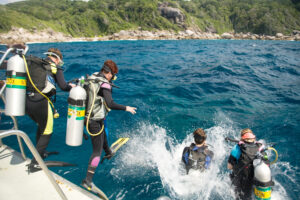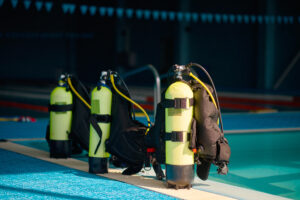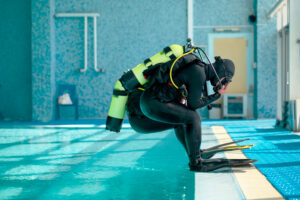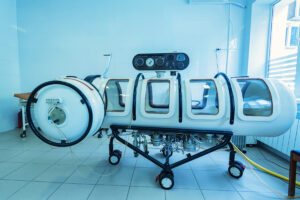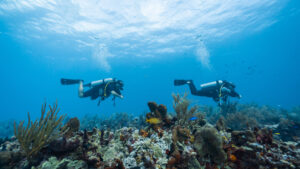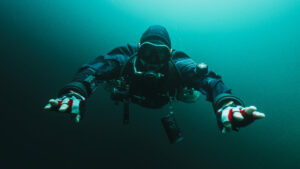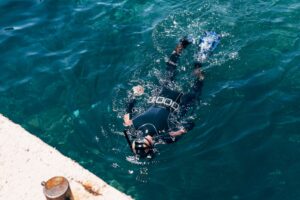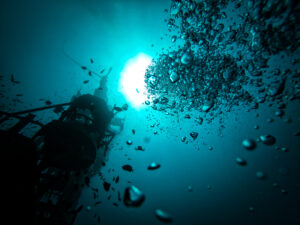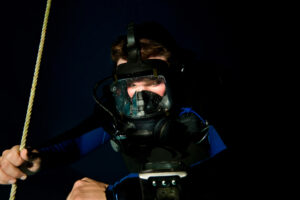High Pressure Nervous Syndrome (HPNS)
High Pressure Nervous Syndrome (HPNS), also known as Helium Tremors, is a neurological disorder that primarily affects deep-sea divers who use breathing gases containing helium during their dives. HPNS is a significant concern for commercial, military, and scientific divers who perform deep saturation dives, as it can impair the diver’s cognitive and physical abilities, and in severe cases, compromise the safety and success of the dive.
Causes: HPNS is predominantly caused by the use of helium-rich breathing gas mixtures in deep-sea diving. Helium is incorporated into the breathing gas to reduce the risk of nitrogen narcosis, a dangerous condition arising from breathing nitrogen under high pressure. However, the use of helium also results in a unique set of physiological changes in the body due to its low molecular weight and rapid diffusion through tissues.
When a diver descends to great depths, the increased pressure causes the helium to dissolve into the body’s tissues. The exact mechanism underlying HPNS is not yet fully understood, but it is believed to be caused by the combination of high pressure and the specific effects of helium on the central nervous system (CNS). Researchers speculate that HPNS may result from changes in the neuronal membrane properties, alterations in neurotransmitter release, or the disruption of ion channel function.
Symptoms: The symptoms of HPNS can vary widely in severity and can manifest as mild to severe depending on various factors, including the depth of the dive, the rate of descent, and the breathing gas mixture. Some of the most common symptoms include:
- Tremors: Involuntary shaking of the limbs, which can range from mild to severe and impair a diver’s ability to perform tasks requiring fine motor skills.
- Myoclonic jerking: Sudden, involuntary muscle contractions that can be mild or severe and affect the diver’s mobility and coordination.
- Somnolence: Excessive sleepiness or drowsiness, which can impair the diver’s alertness and reaction time.
- Electroencephalogram (EEG) changes: Abnormal electrical activity in the brain, which can be detected using an EEG and may indicate alterations in the CNS function.
- Visual disturbances: Divers may experience blurred vision, double vision, or difficulty focusing, which can hinder their ability to navigate and perform tasks underwater.
- Nausea and dizziness: Divers may experience a general feeling of unease, disorientation, or vertigo, which can affect their balance and coordination.
- Decreased mental performance: Divers may exhibit impaired memory, concentration, or decision-making abilities, which can compromise the success and safety of the dive.
Management and Prevention: Although there is no definitive cure for HPNS, there are several strategies that divers can employ to minimize its impact and ensure the safety and success of their deep dives:
- Gradual compression: Slowing down the rate of descent can give the body more time to acclimate to the increased pressure and reduce the likelihood of developing HPNS symptoms.
- Breathing gas optimization: Adjusting the gas mixture to include a lower proportion of helium or incorporating other gases like hydrogen or neon may help reduce the severity of HPNS symptoms.
- In-water recompression: In some cases, divers may be able to alleviate HPNS symptoms by ascending to a shallower depth for a short period before resuming their dive.
Conclusion: High Pressure Nervous Syndrome (HPNS) is a critical consideration for divers engaging in deep-sea dives using helium-rich breathing gas mixtures. Understanding the causes, symptoms, and management strategies for HPNS is essential for divers to safely and successfully navigate the unique challenges presented by deep saturation diving. Ongoing research into the mechanisms
underlying HPNS and the development of new technologies and diving techniques will continue to improve the safety and effectiveness of deep-sea diving operations.
- Acclimatization dives: Performing a series of progressively deeper dives before attempting the target depth can help divers adapt to the increased pressure and reduce the severity of HPNS symptoms. This strategy is particularly useful for divers who are new to deep diving or have not dived to such depths in a while.
- Proper hydration and nutrition: Ensuring adequate hydration and maintaining a balanced diet can help divers maintain optimal physiological function during deep dives. Good nutrition and hydration can support the body’s ability to cope with the effects of increased pressure and mitigate the impact of HPNS.
- Monitoring and communication: Continuous monitoring of a diver’s physical and mental condition during deep dives is crucial for early detection and management of HPNS symptoms. Divers should be encouraged to communicate any symptoms they are experiencing to their dive team, and dive supervisors should be prepared to modify the dive plan or abort the dive if necessary to ensure the safety of the diver.
- Training and education: Comprehensive training and education programs should be provided to deep-sea divers to help them recognize and manage HPNS symptoms. This training should include information on the causes of HPNS, the potential risks associated with the disorder, and the steps that can be taken to prevent or minimize its impact.
Future Research and Technological Advances: The field of deep-sea diving continues to evolve, with ongoing research efforts aimed at improving our understanding of HPNS and developing new technologies and techniques to enhance diver safety and performance. Some of the promising areas of research and innovation include:
- Understanding the molecular mechanisms of HPNS: A deeper understanding of the biochemical and physiological processes that contribute to HPNS will help inform the development of targeted therapies and prevention strategies.
- Advanced gas mixtures: The development of new breathing gas mixtures that provide the benefits of helium without the associated risk of HPNS could revolutionize deep-sea diving.
- Diving equipment innovations: Technological advances in diving equipment, such as rebreather systems and underwater habitats, may help divers manage the challenges associated with deep diving and reduce the risk of HPNS.
In conclusion, High Pressure Nervous Syndrome (HPNS) is a complex and potentially dangerous condition that affects deep-sea divers using helium-rich breathing gases. By understanding the causes, symptoms, and management strategies for HPNS, divers can take appropriate precautions to minimize its impact and ensure the safety and success of their dives. As research continues to advance our understanding of HPNS and innovative technologies are developed, the risks associated with deep-sea diving can be further mitigated, allowing divers to safely explore the depths of our oceans.

